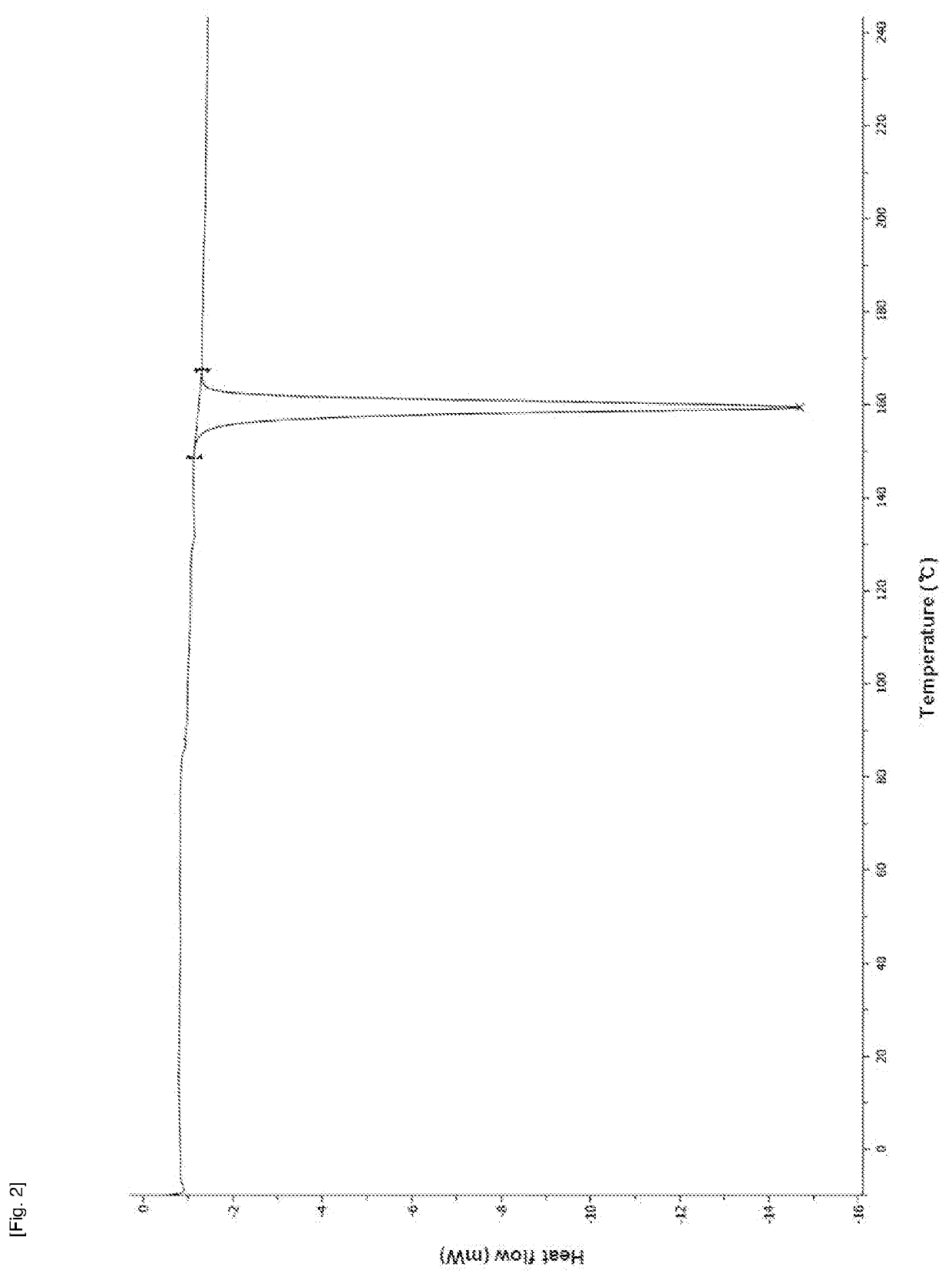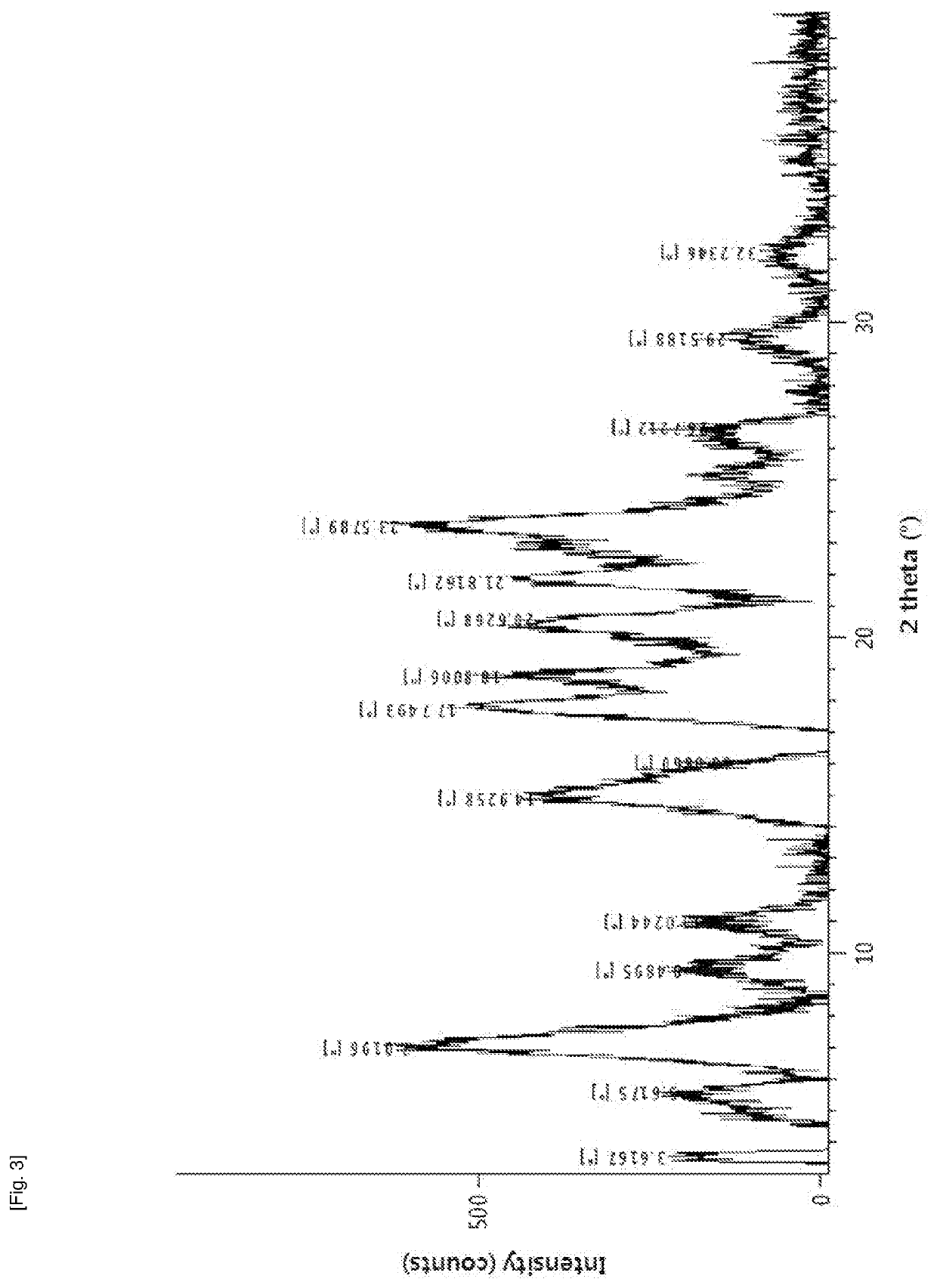Method for producing diphenylmethane derivative
a diphenylmethane and derivative technology, applied in the direction of metabolism disorder, separation process, crystallization auxillary selection, etc., can solve the problems of having to go through the synthesis of diphenylmethane again from the beginning, low final yield, etc., to achieve simple synthesis pathway, improve reproducibility, and high yield
- Summary
- Abstract
- Description
- Claims
- Application Information
AI Technical Summary
Benefits of technology
Problems solved by technology
Method used
Image
Examples
example 1
of (2S,3R,4R,5S,6R)-2-(7-chloro-6-(4-cyclopropylbenzyl)-2,3-dihydrobenzofuran-4-yl)-6-(hydroxymethyl)tetrahydro-2H-pyran-3,4,5-triol
[0305]
Step 1: Methyl 5-bromo-2-chloro-3-hydroxybenzoate (Compound c29)
[0306]To a solution of methyl 5-bromo-2-chloro-3-methoxybenzoate (Compound c5; 30.0 g, 107.3 mmol) in CH2Cl2 (300 mL) was slowly added BBr3 (25.9 mL, 268.3 mmol) at 0° C. under nitrogen atmosphere. The mixture was warmed up to room temperature slowly and stirred at room temperature for 15 hours. The reaction mixture was quenched with MeOH (100 mL) at 0° C. The mixture was evaporated under reduced pressure to remove CH2Cl2, and then MeOH (150 mL) was supplied to it. The resulting mixture was stirred at room temperature for 16 hours. The reaction mixture was concentrated in vacuo to provide the title compound (29.4 g, 110.8 mmol, 103%).
[0307]1H NMR (400 MHz, CDCl3) δ 7.60 (d, J=2.4 Hz, 1H), 7.36 (d, J=2.4 Hz, 1H), 6.00 (s, 1H), 3.94 (s, 1H); [M+H]+ 265.
Step 2: Methyl 3-(allyloxy)-5-brom...
example 2
of (2S,3R,4R,5S,6R)-2-(7-chloro-6-(4-cyclopropylbenzyl)-2,3-dihydrobenzofuran-4-yl)-6-(hydroxymethyl)tetrahydro-2H-pyran-3,4,5-triol
[0340]
Step 1: (3R,4S,5R,6R)-2-(7-Chloro-6-(4-cyclopropylbenzyl)-2,3-dihydrobenzofuran-4-yl)-3,4,5-tris(trimethylsilyloxy)-6-((trimethylsilyloxy)methyl)tetrahydro-2H-pyran-2-ol (Compound c41)
[0341]To a solution of 4-bromo-7-chloro-6-(4-cyclopropylbenzyl)-2,3-dihydrobenzofuran (Compound c40, 5.00 g, 13.8 mmol) in tetrahydrofuran (140 mL) was added dropwise n-butyllithium (2.5 M in hexane, 8.28 mL, 20.7 mmol) at −78° C. under a nitrogen atmosphere. After performing stirring at the same temperature for 5 minutes, to the mixture was added dropwise a solution of TMS-protected lactone (Compound ell; 7.70 g, 16.6 mmol) in tetrahydrofuran for 30 minutes. The reaction mixture was stirred at the same temperature for 1 hour. The reaction mixture was quenched with a saturated NH4Cl aqueous solution (300 mL) at 0° C., and extraction with EtOAc was performed. The orga...
example 3
of (2S,3R,4R,5S,6R)-2-(7-chloro-6-(4-methoxybenzyl)-2,3-dihydrobenzofuran-4-yl)-6-(hydroxymethyl)tetrahydro-2H-thiopyran-3,4,5-triol
[0347]
Step 1: (3R,4S,5S,6R)-3,4,5-tris(benzyloxy)-6-((benzyloxy)methyl)-2-(7-chloro-6-(4-methoxybenzyl)-2,3-dihydrobenzofuran-4-yl)tetrahydro-2H-thiopyran-2-ol (Compound c52)
[0348]The synthesis procedure of step 8 in Example 4 was repeated except that 4-bromo-7-chloro-2,3-dihydrobenzofuran-6-carbaldehyde was used as a starting material and (4-methoxyphenyl)magnesium bromide (Compound c48) was used as a Grignard reagent to provide (4-bromo-7-chloro-2,3-dihydrobenzofuran-6-yl)(4-methoxyphenyl)methanol (Compound c49). Then the synthesis procedure of step 9 in Example 4 was repeated except that (4-bromo-7-chloro-2,3-dihydrobenzofuran-6-yl)(4-methoxyphenyl)methanol (Compound c49) was used as a starting material to provide 4-bromo-7-chloro-6-(4-methoxybenzyl)-2,3-dihydrobenzofuran (Compound c50).
[0349]To a solution of 4-bromo-7-chloro-6-(4-methoxybenzyl)-2,3-...
PUM
| Property | Measurement | Unit |
|---|---|---|
| temperature | aaaaa | aaaaa |
| temperature | aaaaa | aaaaa |
| temperature | aaaaa | aaaaa |
Abstract
Description
Claims
Application Information
 Login to View More
Login to View More - R&D
- Intellectual Property
- Life Sciences
- Materials
- Tech Scout
- Unparalleled Data Quality
- Higher Quality Content
- 60% Fewer Hallucinations
Browse by: Latest US Patents, China's latest patents, Technical Efficacy Thesaurus, Application Domain, Technology Topic, Popular Technical Reports.
© 2025 PatSnap. All rights reserved.Legal|Privacy policy|Modern Slavery Act Transparency Statement|Sitemap|About US| Contact US: help@patsnap.com



